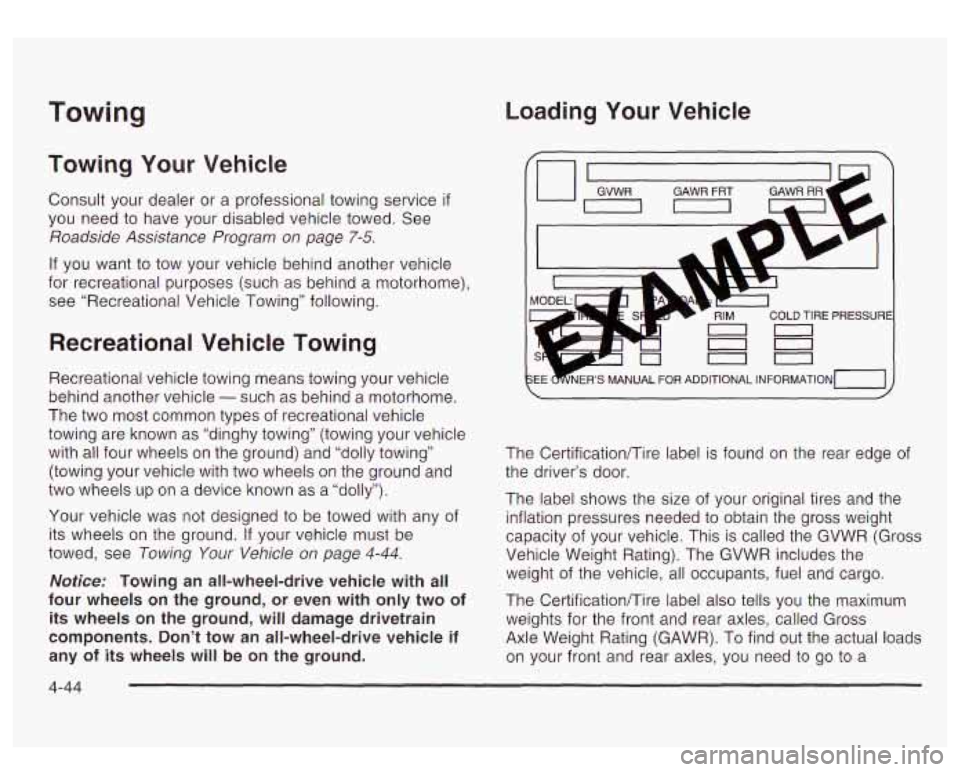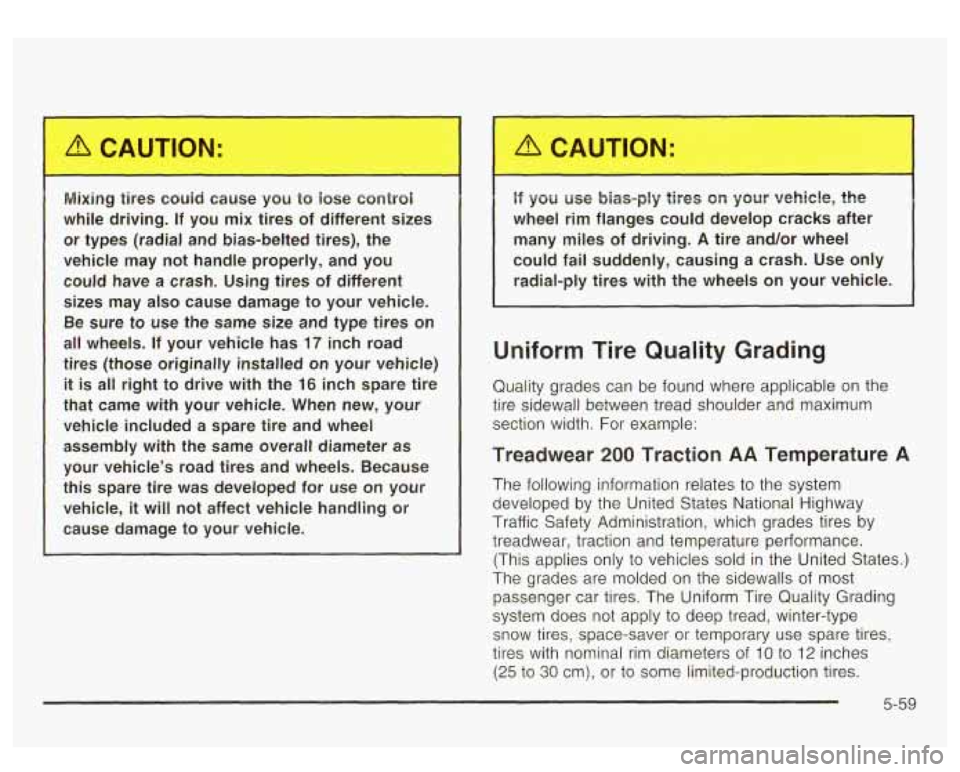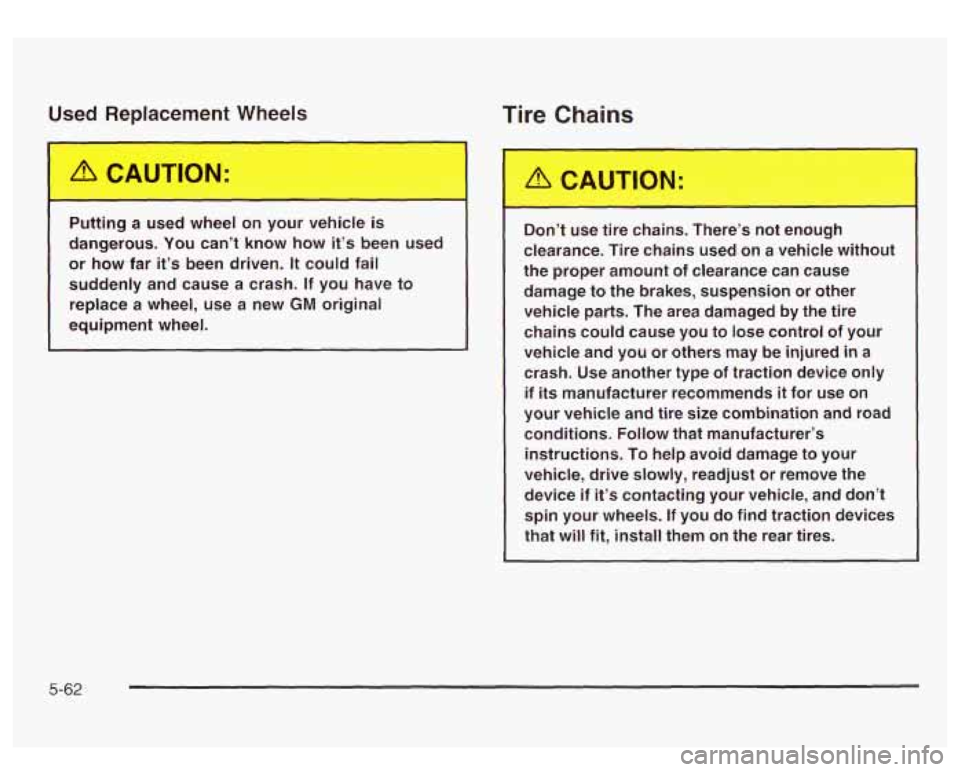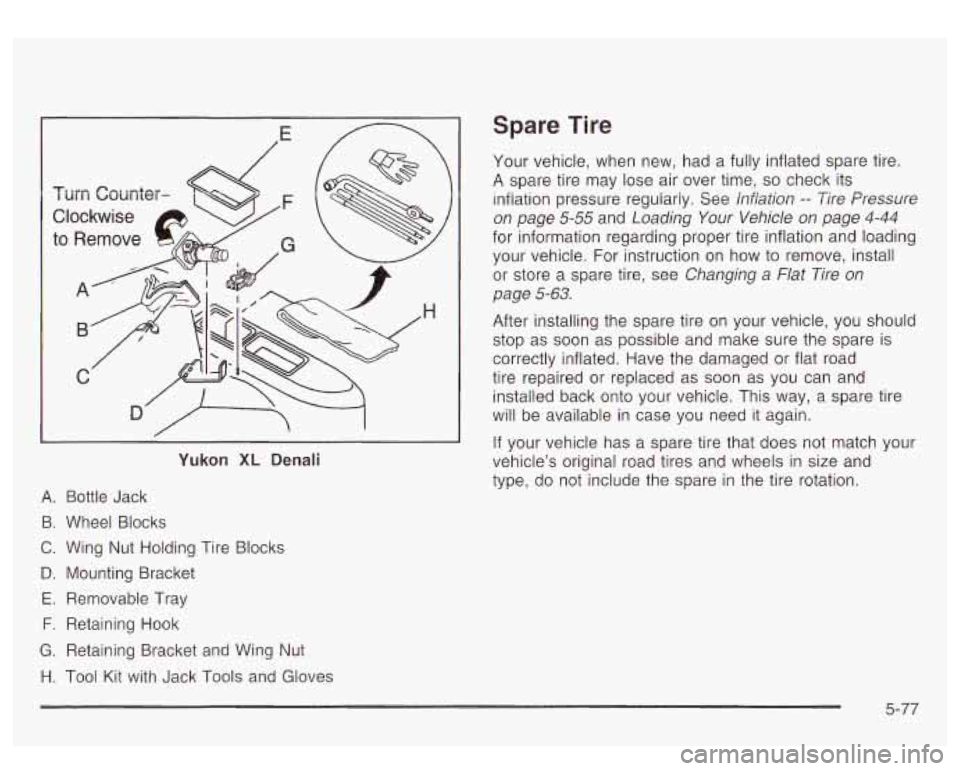wheel size GMC YUKON DENALI 2003 Owners Manual
[x] Cancel search | Manufacturer: GMC, Model Year: 2003, Model line: YUKON DENALI, Model: GMC YUKON DENALI 2003Pages: 447, PDF Size: 21.97 MB
Page 277 of 447

Towing Loading Your Vehicle
Towing Your Vehicle
Consult your dealer or a professional towing service if
you need to have your disabled vehicle towed. See
Roadside Assistance Program on page
7-5.
If you want to tow your vehicle behind another vehicle
for recreational purposes (such as behind a motorhome),
see “Recreational Vehicle Towing” following.
Recreational Vehicle Towing
Recreational vehicle towing means towing your vehicle
behind another vehicle
- such as behind a motorhome.
The two most common types of recreational vehicle
towing are known as “dinghy towing” (towing your vehicle
with all four wheels on the ground) and “dolly towing”
(towing your vehicle with two wheels
on the ground and
two wheels
up on a device known as a “dolly”).
Your vehicle was not designed
to be towed with any of
its wheels on the ground.
If your vehicle must be
towed, see Towing Your Vehicle on page
4-44.
Notices Towing an all-wheel-drive vehicle with all
four wheels on the ground, or even with only two
of
its wheels on the ground, will damage drivetrain
components. Don’t tow an all-wheel-drive vehicle
if
any of its wheels will be on the ground.
II II
GAWR FRT GAWR RR
!E mNERS MANUAL FOR ADDITIONAL INFORMATION[-]
The Certificationmire label is found on the rear edge of
the driver’s door.
The label shows the size of your original tires and the
inflation pressures needed
to obtain the gross weight
capacity of your vehicle. This is called the GVWR (Gross
Vehicle Weight Rating). The GVWR includes the
weight of the vehicle, all occupants, fuel and cargo.
The Certificationmire label also tells you the maximum
weights for the front and rear axles, called Gross
Axle Weight Rating (GAWR). To find out the actual loads
on your front and rear axles, you need to go
to a
4-44
Page 348 of 447

Mixing tires could cause you to iose control
while driving. If you mix tires of different sizes or types (radial and bias-belted tires), the
vehicle may not handle properly, and you
could have a crash. Using tires of different
sizes may also cause damage to your vehicle.
Be sure to use the same size and type tires on
all wheels. If your vehicle has
17 inch road
tires (those originally installed
on your vehicle)
it is all right to drive with the 16 inch spare tire
that came with your vehicle. When new, your
vehicle included a spare tire and wheel
assembly with the same overall diameter as
your vehicle’s road tires and wheels. Because
this spare tire was developed for use on your
vehicle,
it will not affect vehicle handling or
cause damage to your vehicle.
if you use bias-ply tires on your vehicle, the
wheel rim flanges could develop cracks after many miles of driving.
A tire and/or wheel
could fail suddenly, causing a crash. Use only radial-ply tires with the wheels on your vehicle
Uniform Tire Quality Grading
Quality grades can be found where applicable on the
tire sidewall between tread shoulder and maximum
section width. For example:
Treadwear 200 Traction AA Temperature A
The following information relates to the system
developed by the United States National Highway
Traffic Safety Administration, which grades tires by
treadwear, traction and temperature performance.
(This applies only to vehicles sold in the United States.)
The grades are molded on the sidewalls of most
passenger car tires. The Uniform Tire Quality Grading
system does not apply to deep tread, winter-type
snow tires, space-saver or temporary use spare tires,
tires with nominal rim diameters of
10 to 12 inches
(25 to 30 cm), or to some limited-production tires.
5-59
Page 351 of 447

Used Replacement Wheels Tire Chains
-
Putting a used wheel on your vehicle is
dangerous. You can’t know how
it’s been used
or how far
it’s been driven. It could fail
suddenly and cause a crash. If you have to replace
a wheel, use a new GM original
equipment wheel. Don’t use
ti., ch; ... s. There’s
not ,..ough
clearance. Tire chains used
on a vehicle without
the proper amount of clearance can cause
damage to the brakes, suspension or other
vehicle parts. The area damaged by the tire
chains could cause you to lose control of your
vehicle and you or others may be injured
in a
crash. Use another type of traction device only
if its manufacturer recommends
it for use on
your vehicle and tire size combination and road conditions. Follow that manufacturer’s instructions. To help avoid damage to your
vehicle, drive slowly, readjust or remove
the
device if it’s contacting your vehicle, and don’t
spin your wheels.
If you do find traction devices
that will
fit, install them on the rear tires.
5-62
Page 366 of 447

Yukon XL Denali
A. Bottle Jack
B. Wheel Blocks
C. Wing Nut Holding Tire Blocks
D. Mounting Bracket
E. Removable Tray
F. Retaining Hook
G. Retaining Bracket and Wing Nut
H. Tool Kit with Jack Tools and Gloves
Spare Tire
Your vehicle, when new, had a fully inflated spare tire.
A spare tire may lose air over time, so check its
inflation pressure reguiariy. See infiation
-- Tire Pressure
on page
5-55 and Loading Your Vehicle on page 4-44
for information regarding proper tire inflation and loading
your vehicle. For instruction on how to remove, install
or store a spare tire, see Changing a Flat Tire
on
page 5-63.
After installing the spare tire on your vehicle, you should
stop as soon as possible and make sure the spare is
correctly inflated. Have the damaged or flat road
tire repaired or replaced as soon as you can and
installed back onto your vehicle. This way, a spare tire
will be available in case you need it again.
If your vehicle has a spare tire that does not match your
vehicle’s original road tires and wheels in size and
type,
do not include the spare in the tire rotation.
5-77